In July 2021, Rogério Ceni and Flamengo parted ways after a turbulent period at the club. As a result, Ceni’s ability to manage big clubs was in question. He had performed well at Fortaleza but in a much smaller scenario. Three months later, he returned to the club where he became a football legend, São Paulo, in an attempt to prove himself as one of Brazil’s top managers. After an inconsistent end to the 2021 season, Ceni’s São Paulo have started this season tremendously well, nearly winning the Paulista state championship.
While a few experienced players such as ex-Bayern Rafinha, Patrick, Alisson, and Nikão were signed during the transfer window, their recent success can be attributed to their youth academy. Nearly half of their starting eleven against Palmeiras in the Paulista final were academy products. Known as the ‘Meninos de Cotia’, São Paulo’s youth academy has produced talents such as Casemiro, Lucas, David Neres, and Antony.
In this tactical analysis, São Paulo’s tactics throughout different phases of the game will be analysed in detail. Moreover, this analysis should illustrate how Ceni’s São Paulo play ahead of the 2022 Brasileiro.
Overview
São Paulo had one of the best attacks in the Paulista with 27 goals from 23.68 xG. Furthermore, they had an xGA of just 10.8 – the lowest in the Paulista. It is fair to say Ceni’s São Paulo were effective on both ends. Key metrics can indicate the team’s overall behaviour both in and out of possession. They maintained the highest average PPDA in the Paulista at 7.3. With the ball, they averaged 60.9% possession, only behind Corinthians’ 62.5%. Further metrics include 448 passes per 90, while only 7.66% of them being long. This highlights their controlled approach to possession, based on short and high tempo passing. Finally, they did not average a lot of 1v1s dribbling, which further emphasises this pass-first mentality. In summary, Ceni’s São Paulo look to dominate the ball with controlled possession and a high press.
As far as formations, São Paulo are very dynamic. They line up in a 4-1-3-2, but the structure constantly changes depending on situations and players available. The back four is fairly consistent, with Rafinha, Diego Costa, Léo, and either Welington or Reinaldo being regulars. Pablo Maia is a crucial piece in this São Paulo side. The 20-year-old deep-lying midfielder is crucial to São Paulo’s construction and protecting the backline. Rodrigo Nestor performs a dynamic role in the midfield. While he is the central attacking midfielder, he often drifts deeper into the midfield, both in and out of possession. Alisson and Igor Gomes are usually the other two attacking midfielders, but other players have also been tested. In the attack, Éder plays alongside Calleri, who has been São Paulo’s top goalscorer in the Paulista.
Build up
During the build up phase, São Paulo look to maintain their 4-1-3-2 structure. The centre-backs split the goalkeeper while the fullbacks push up wide. Behind the first line of pressure, Pablo Maia will look to find gaps to receive the ball. As they are structured with a single pivot, they look to build through the middle. São Paulo will often have numerical superiority in the midfield as they line up with four players there. The objective is to always take advantage of this superiority. Below is an example of Pablo Maia’s positioning behind the first line of pressure.
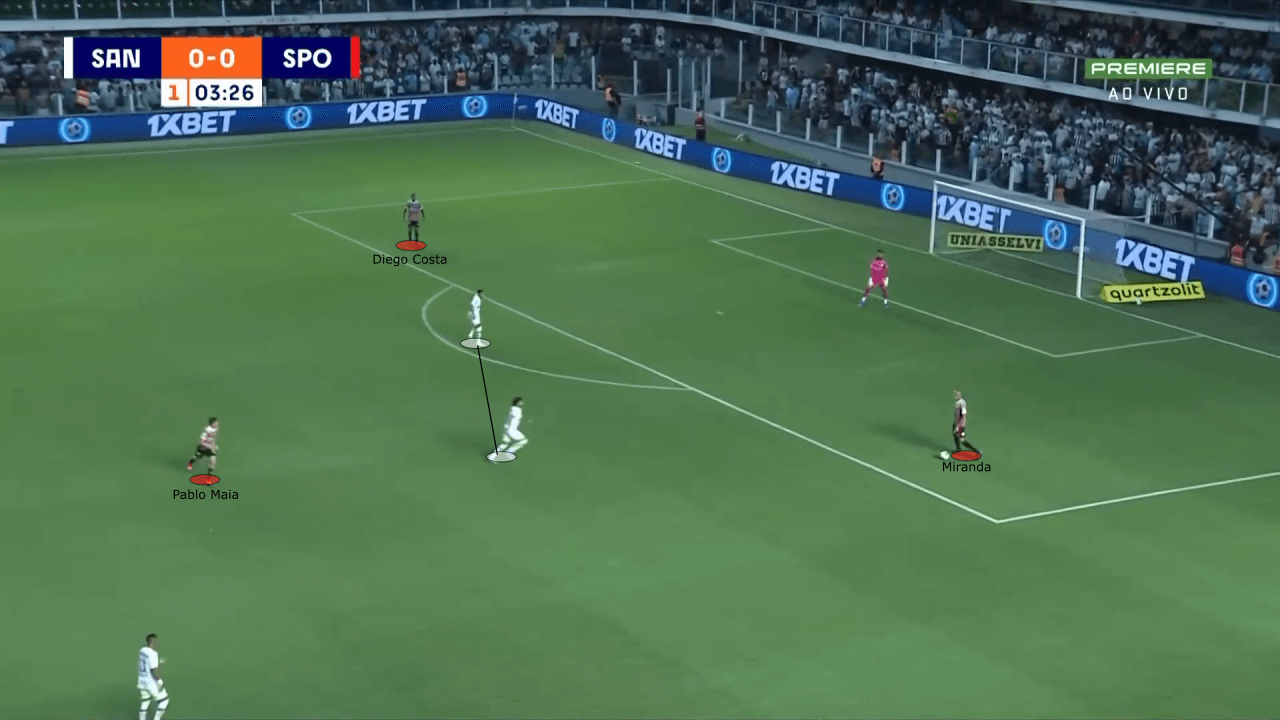
As Santos’ centre-forward blocks Diego Costa from receiving the ball, Pablo Maia shows in the space created in the middle. After receiving, he immediately plays Diego Costa behind the centre-forward.
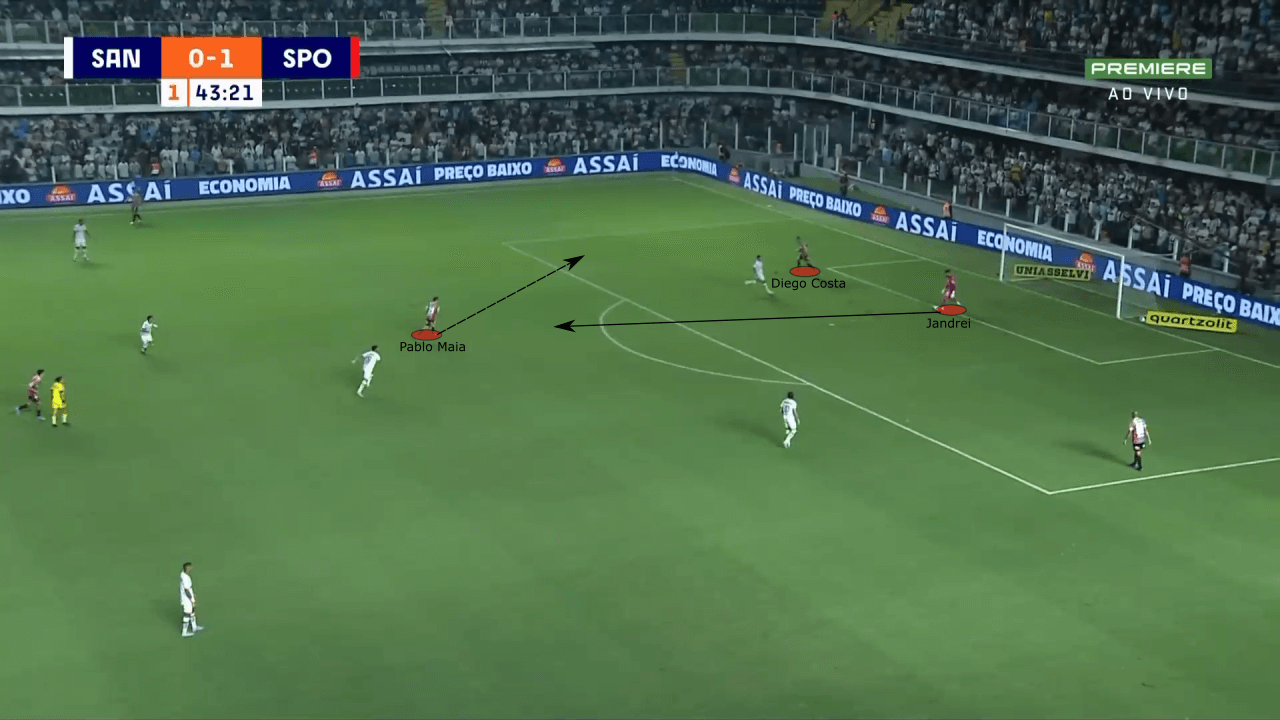
Diego Costa is able to find Gabriel Sara, one of the attacking midfielders, who checks into the space. With this simple combination among the three, São Paulo is able to play through Santos’ high pressure.
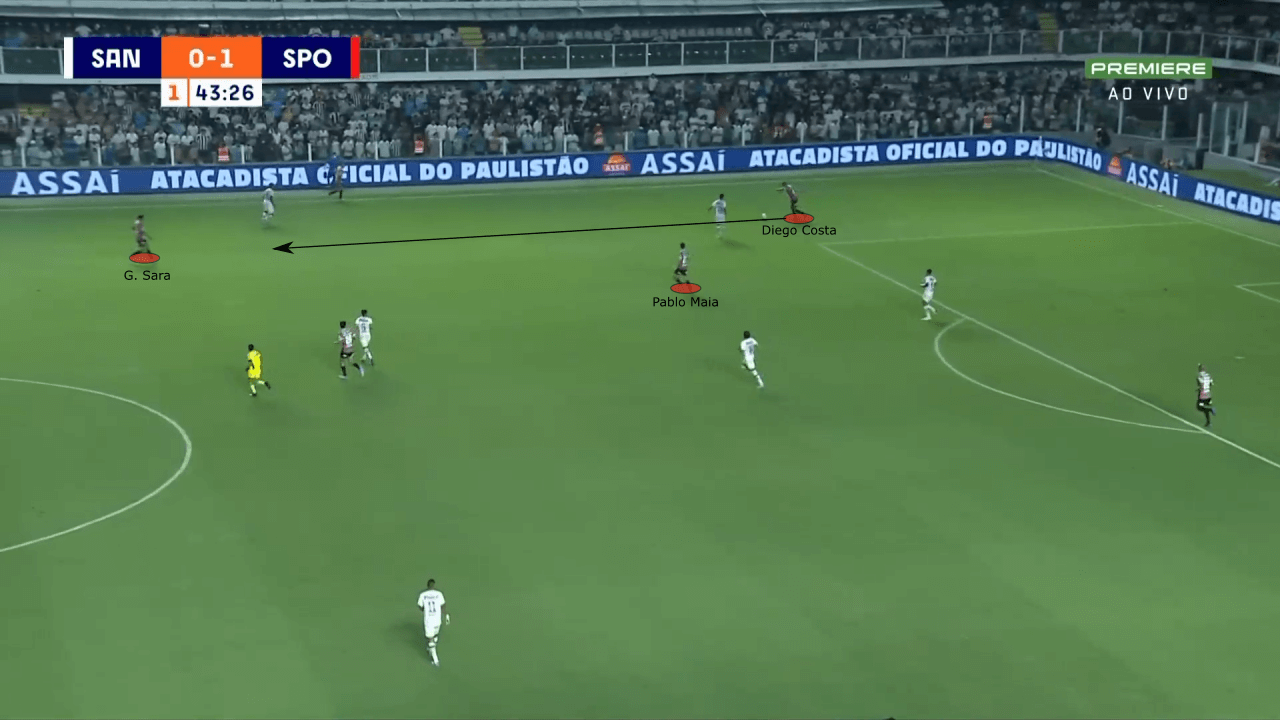
In the semi-final and final against Corinthians and Palmeiras, respectively, a common scenario was exploited. Both teams wanted to match São Paulo’s numbers in the midfield and only left one centre-forward to press. While they were able to cancel the numerical superiority in the midfield, the centre-backs had the advantage over the lone forward. As a consequence, São Paulo’s centre-backs constantly carried the ball further up the pitch and attacked the spaces, especially Léo, as seen below.
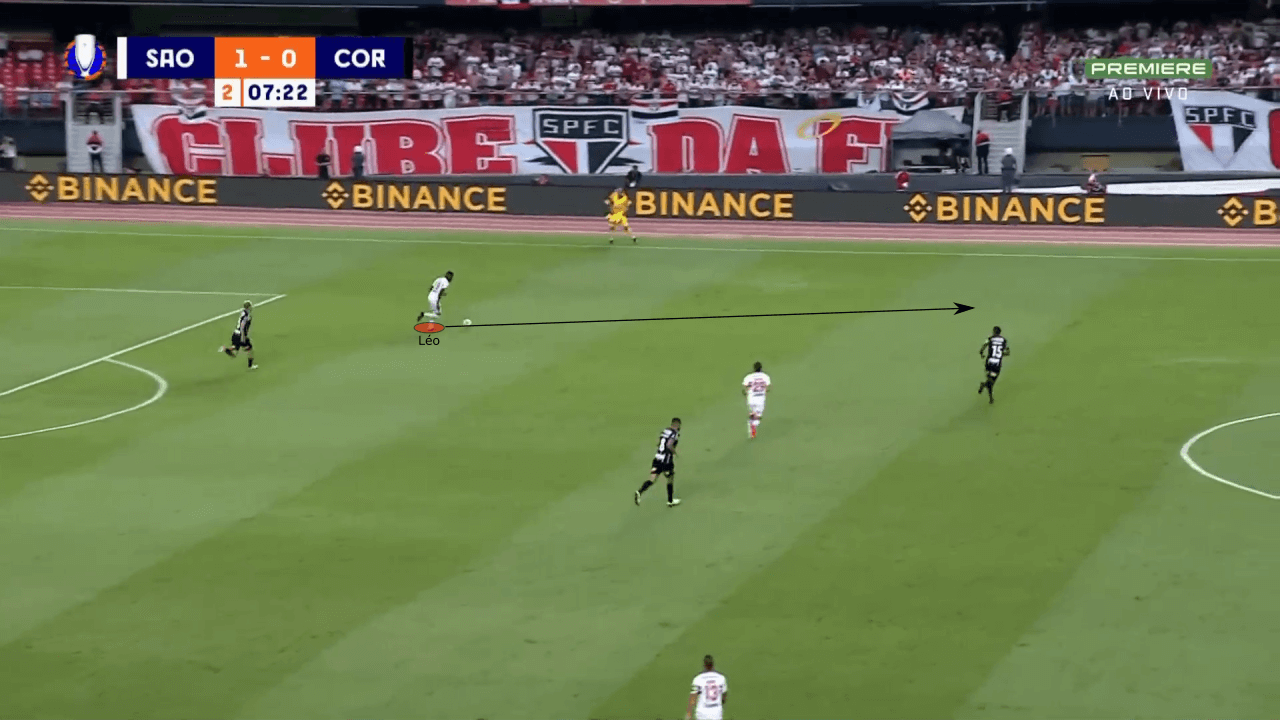
Another common occurrence was Rodrigo Nestor’s support in the build up. As oppositions would look to man-mark or nullify the playmaking of Pablo Maia, Nestor would drop to provide another alternative. Against Corinthains, Paulinho marked Pablo Maia as they looked to advance their press. As a consequence, Nestor drops from higher up the pitch to receive the ball, completely unmarked.
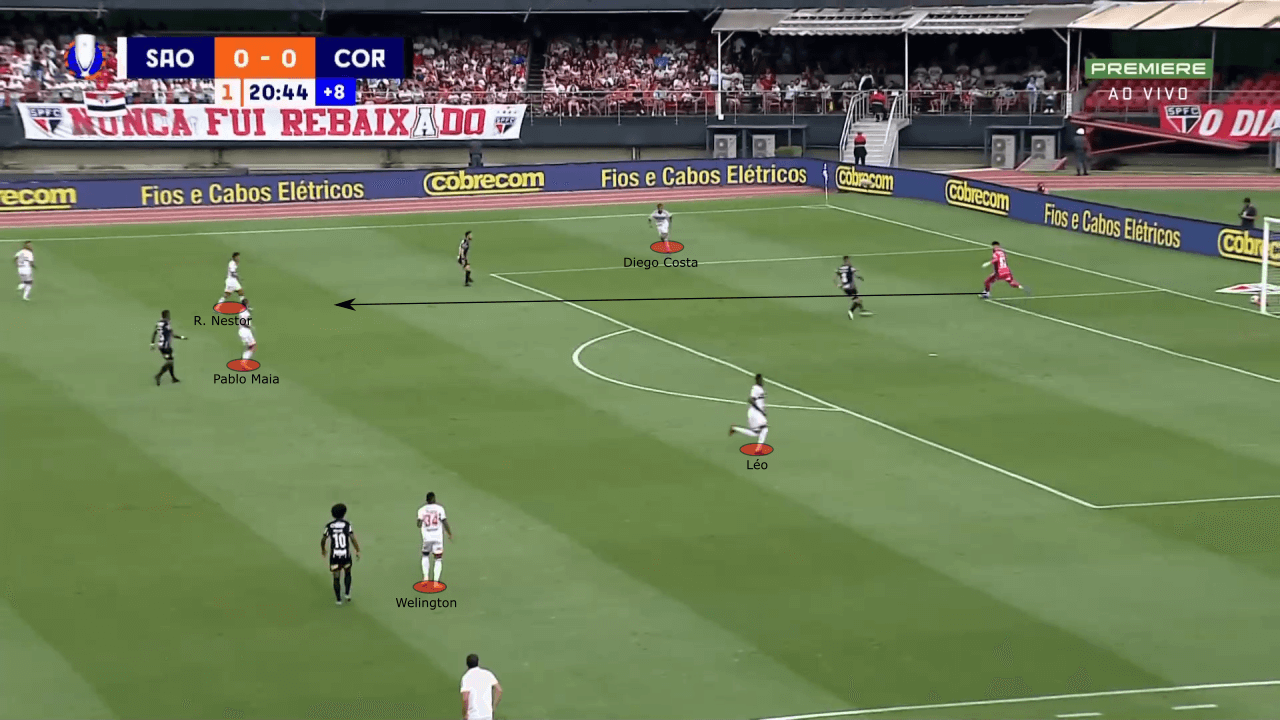
Nestor’s support also provides a numerical advantage. Against Inter de Limeira, Nestor drops near his own box as São Paulo try to build out of the back. By doing this, he creates a 2v1 in that specific area, forcing the opposition player to choose between him or Diego Costa.
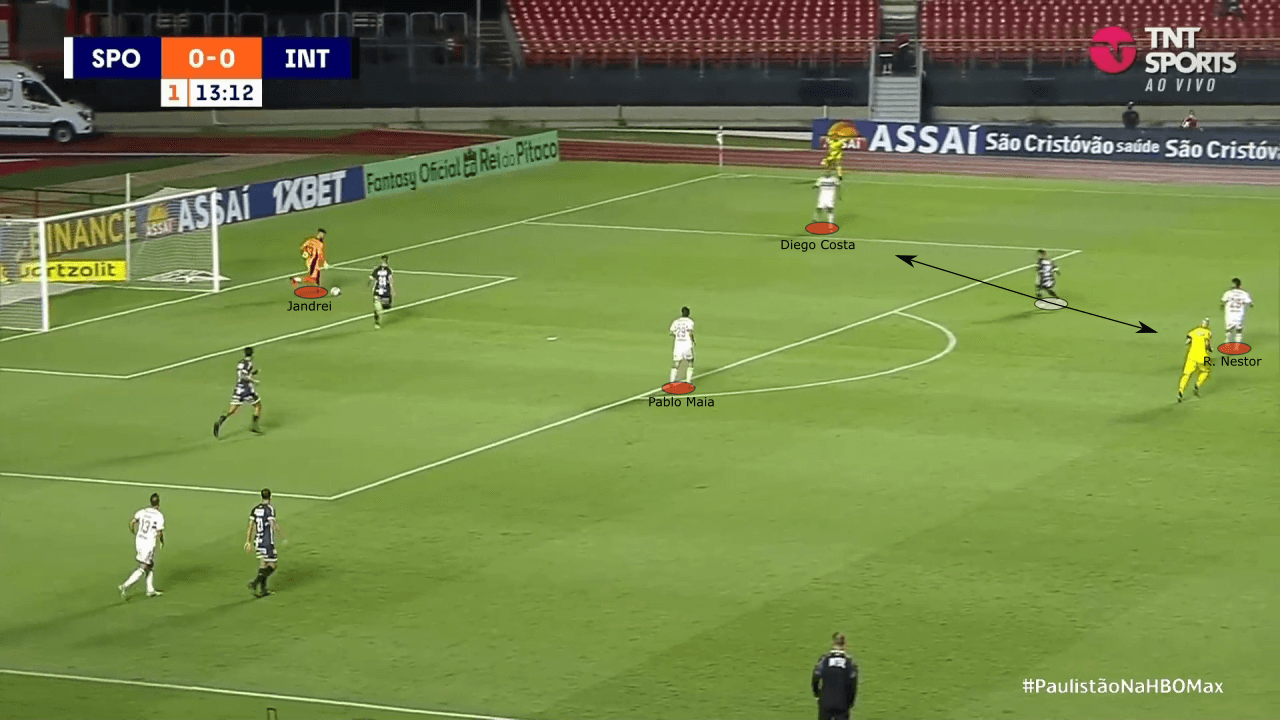
A common variation in the build up is the formation of a line of three. This can be done in multiple ways which will depend on the players available. Its utility and effectiveness will always depend on the opposition’s pressing structure, but it never hurts to have more than one option. One example of this is Pablo Maia dropping between the centre-backs. It allows the midfielders higher up the pitch to drop and occupy the midfield spaces.
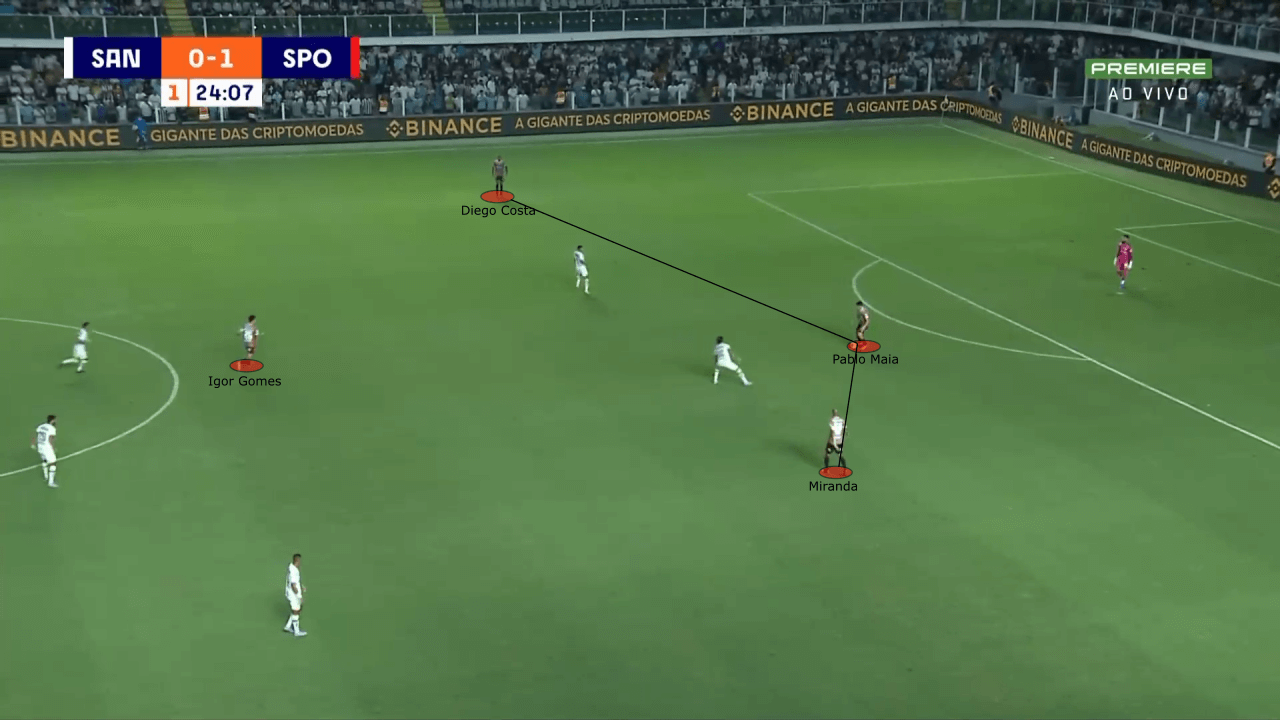
Against Inter de Limeira, Rafinha would often become the third centre-back. Marquinhos was deployed as the right attacking midfielder, although he is naturally a winger. To allow him to occupy and still be effective on the wide channel, this variation was used. Small changes like this are constantly made by Ceni in order to be dynamic and maximise his players’ abilities.
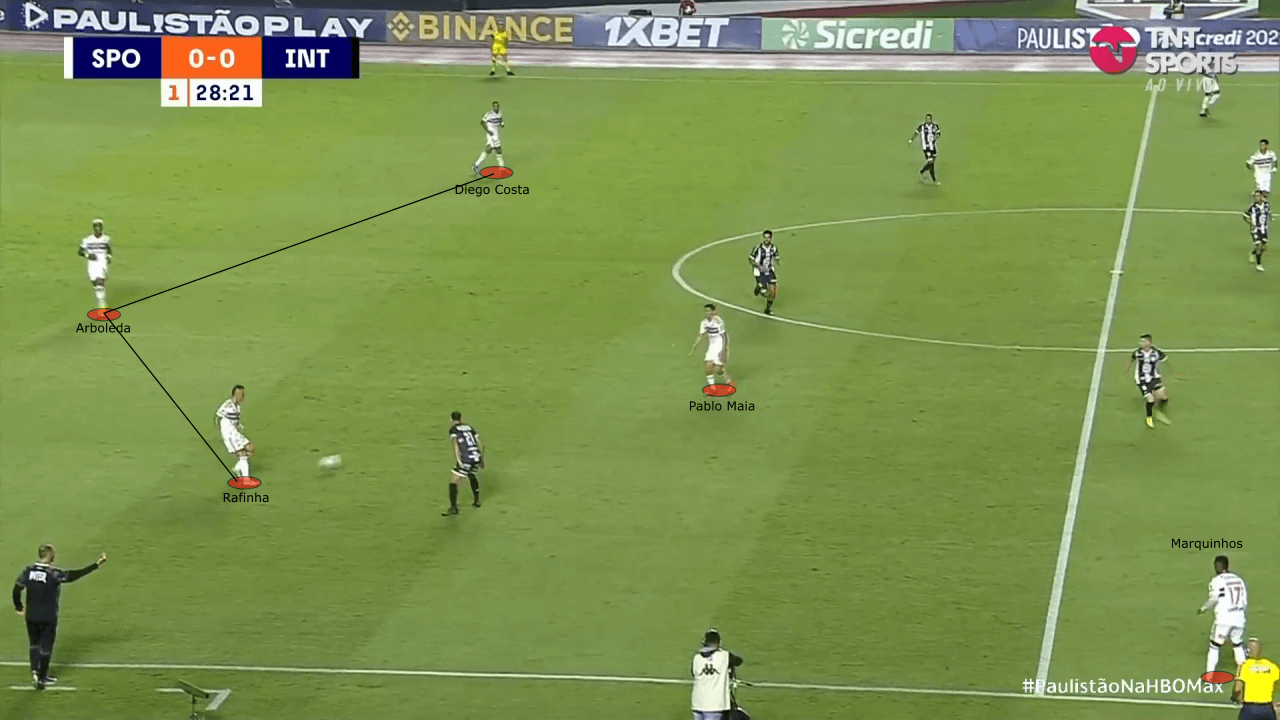
Chance creation
Similarly to the build up phase, São Paulo maintain a 4-1-3-2 structure further up the pitch. Ceni’s São Paulo is a pass-first team that look to collectively progress through the zones and create. As a consequence, players are often very close to each other. More specifically, the attacking midfielders will not drift too far from each other as they often combine between themselves.
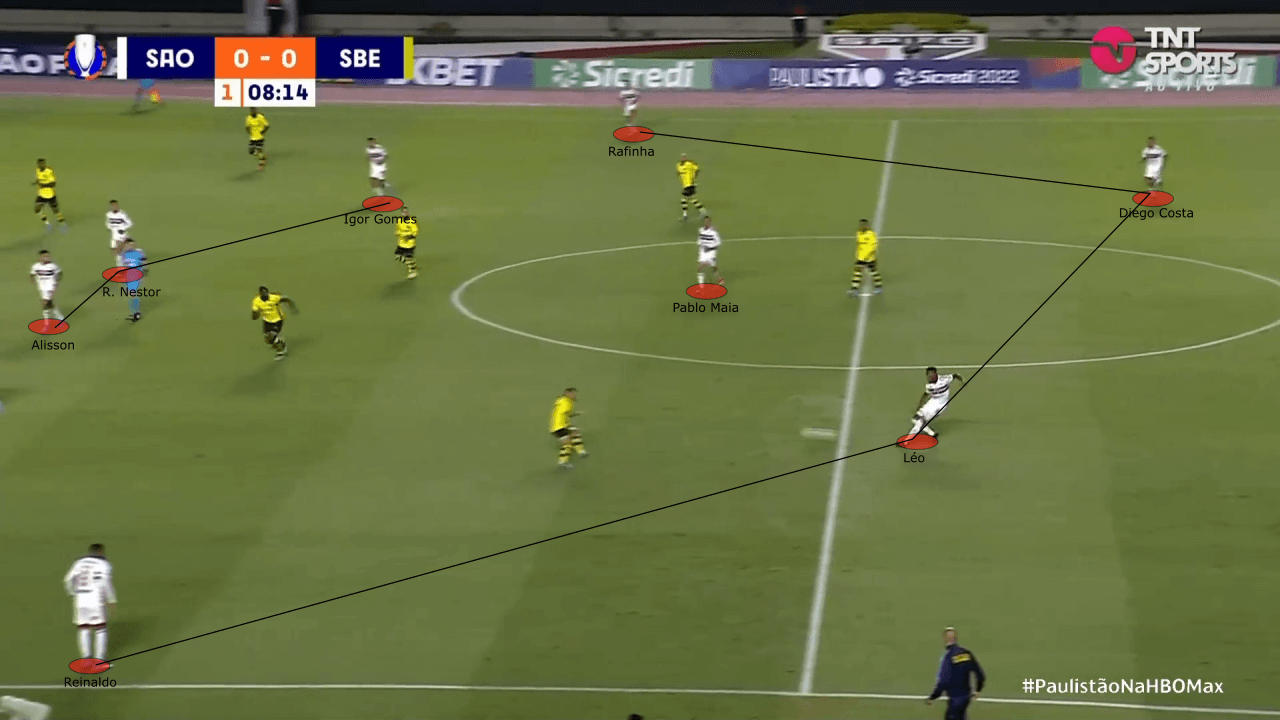
The movement between the centre-forwards is also key in creating chances. With a centre-forward pairing, movements and combinations tend to be very effective. One example of this can be seen below as Luciano drifts slightly inside, behind his partner Éder. Alisson drifts wide to create a passing line for Éder, who checks in to receive the pass. As he does this, space is created between the centre-backs. Luciano attacks this space and quickly receives a flick-on from Éder, allowing him to get in behind.
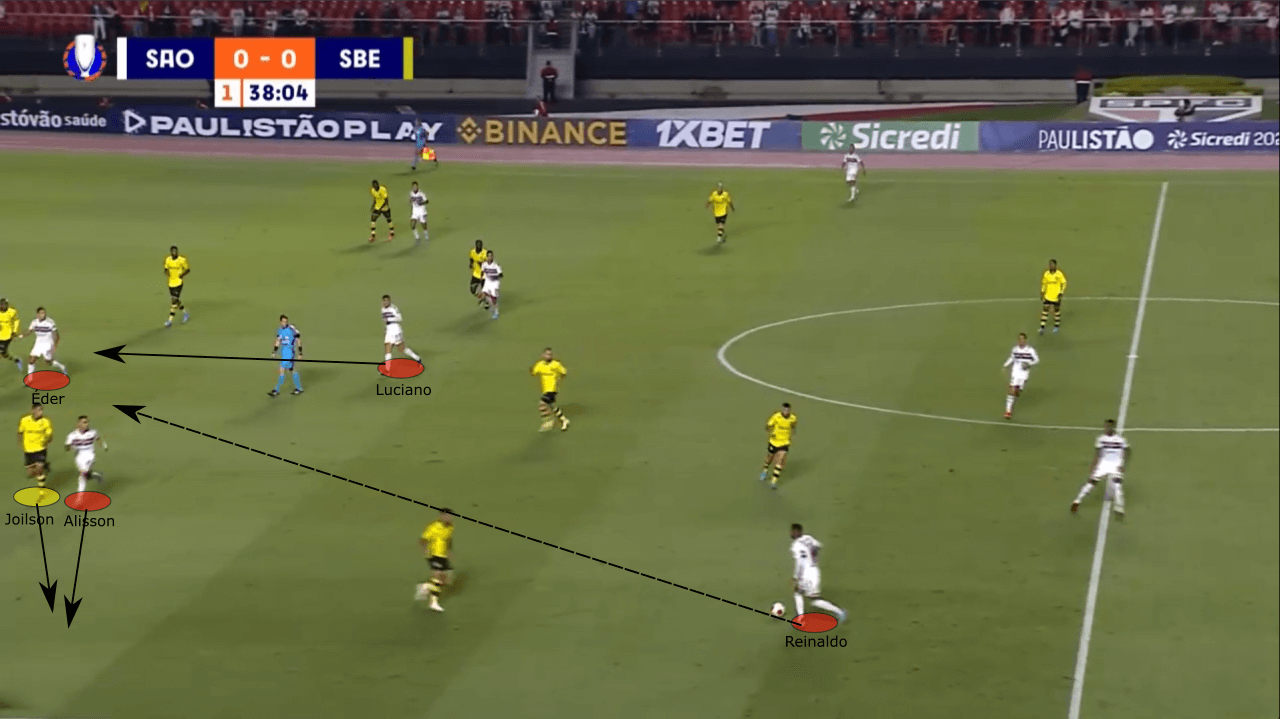
Combinations are a significant part of Ceni’s strategy. The coordination between the three midfielders and the forwards is consequently essential. It allows them to combine quick passes and penetrate the opposition defence. Against Santos below, Gabriel Sara receives a line-breaking pass from Diego Costa. As he receives the ball, Igor Gomes and Éder quickly provide support. The three quickly combine allowing Sara to create space for a shot.
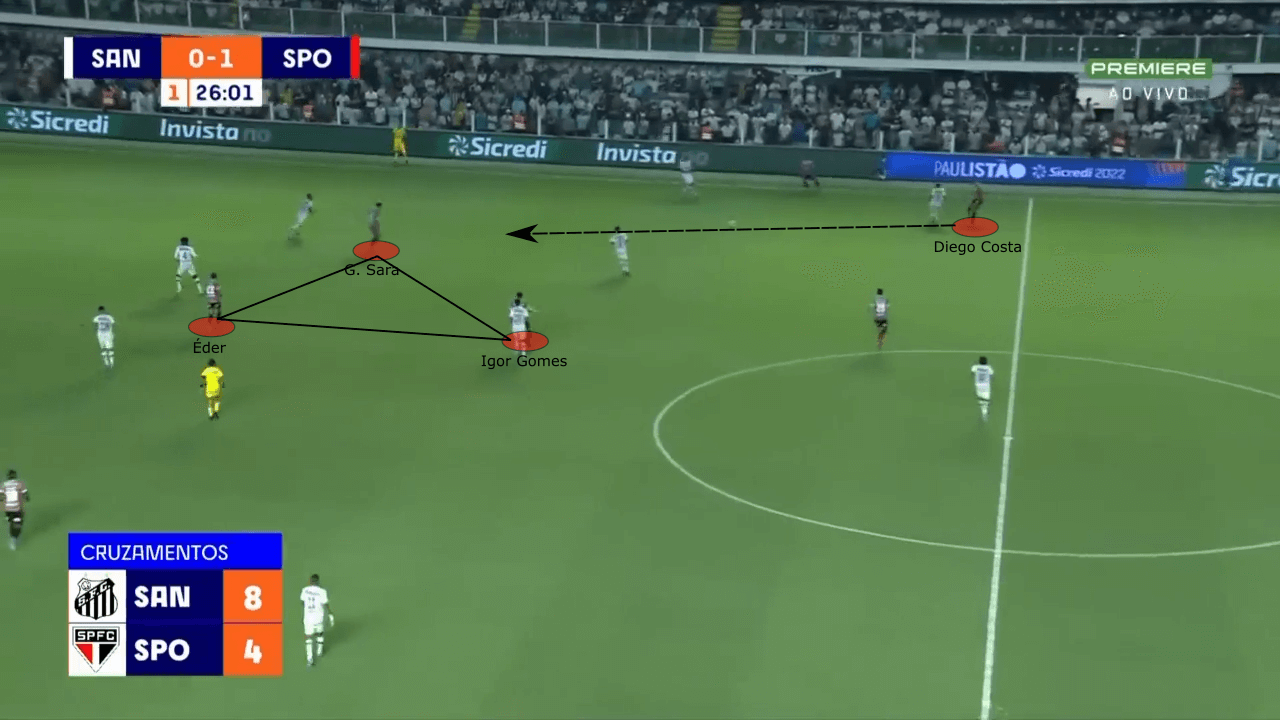
Between themselves, they will also fluctuate between the defensive lines. This creates confusion and disorganisation among the defence. As Nestor drops slightly deeper, the opposition midfielder pushes up to mark him. This movement creates space for Gabriel Sara to run into. Alisson is able to split the defenders and find him behind the midfield line.
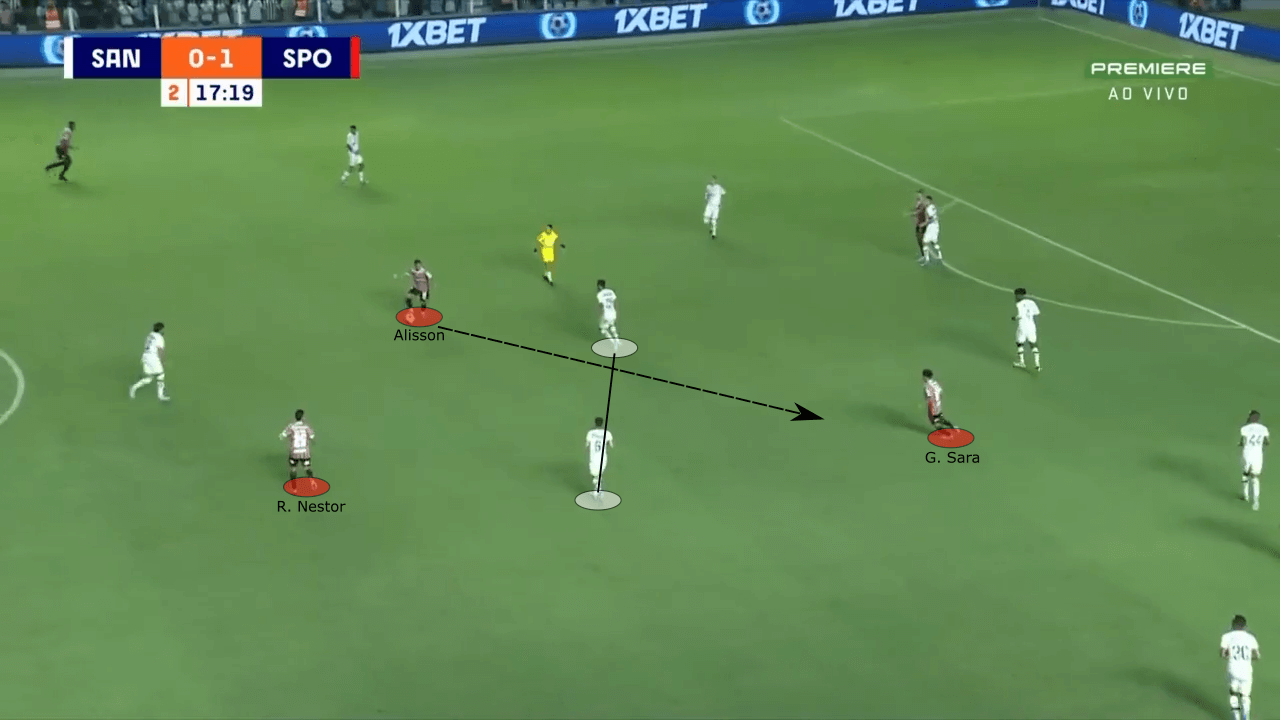
Gabriel Sara is then able to turn and attack Santos’ backline. Nikão, who is playing as a centre-forward, quickly drifts wide and receives a nice through ball into space.
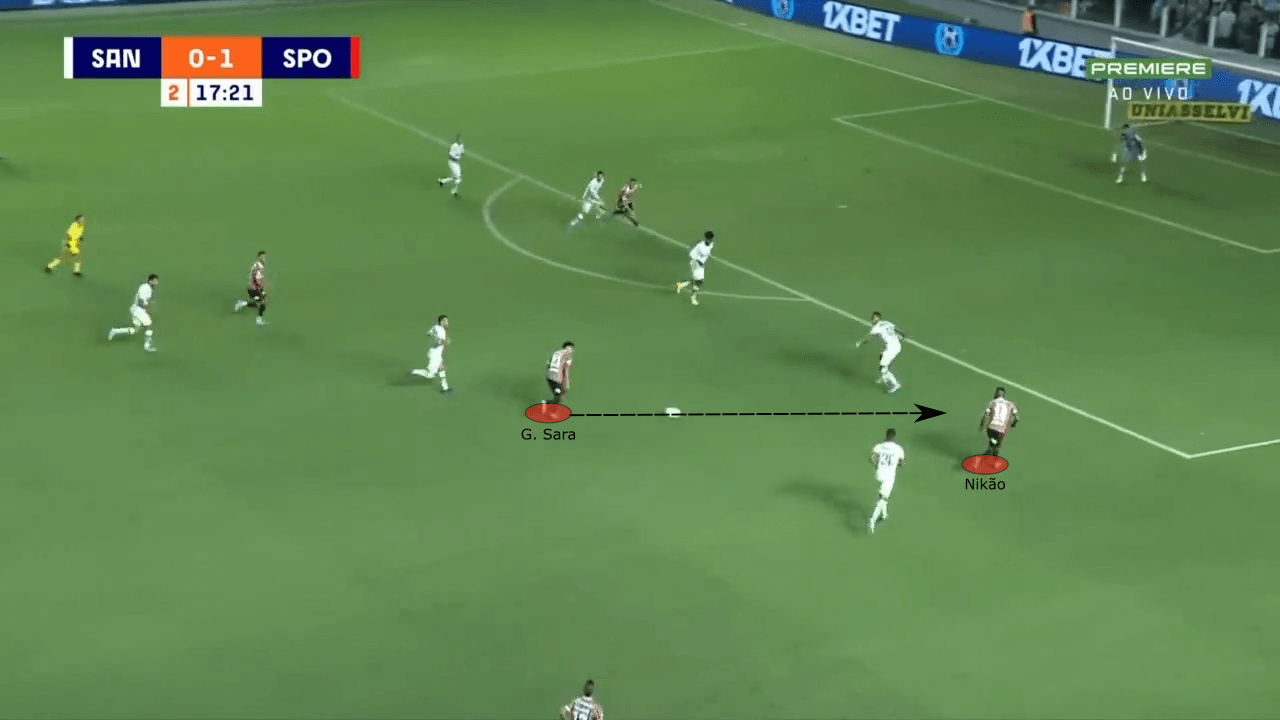
Despite having a relatively narrow formation, player movements and characteristics allow them to use the wide areas as well. Combinations in these areas are very common and effective in getting closer to the opposition’s goal. As previously mentioned, Marquinhos is a player who naturally likes to drift wide. After receiving the ball near the touchline, he passes it into space for Nikão, who is making a run.
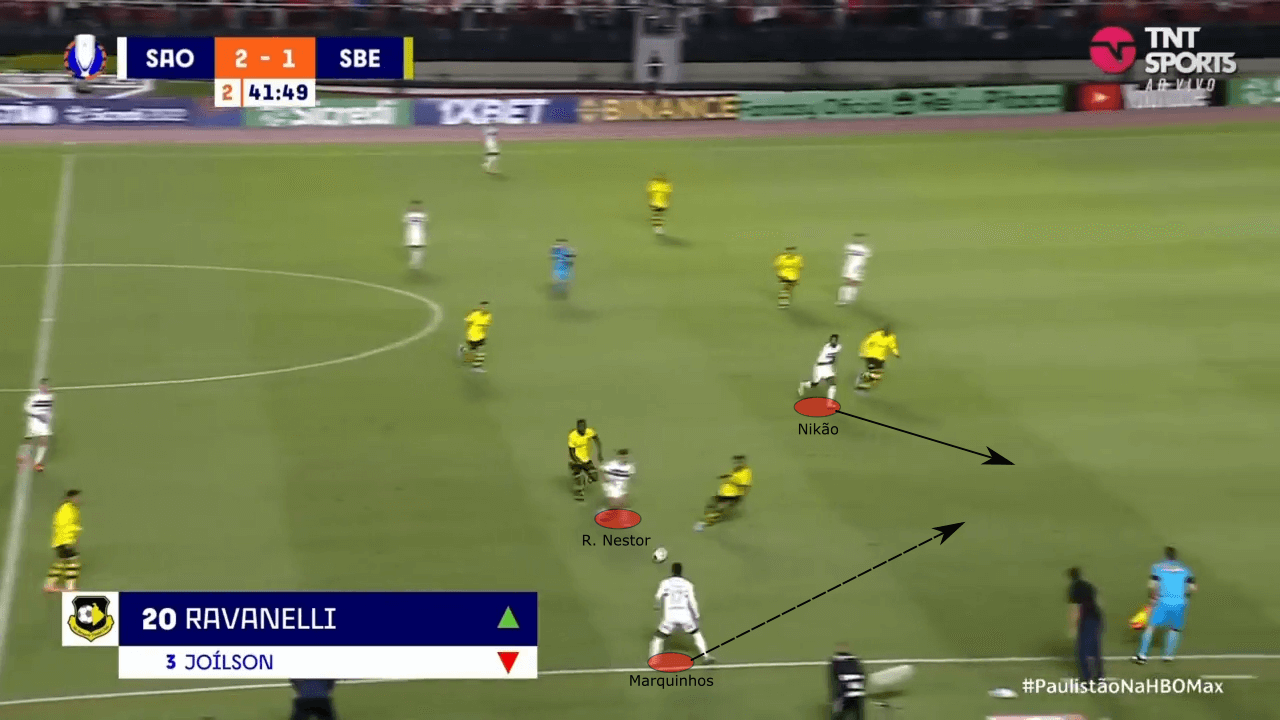
Marquinhos immediately makes a run forward and receives the flick-on from Nikão which allows him to get in behind the opposition’s line.
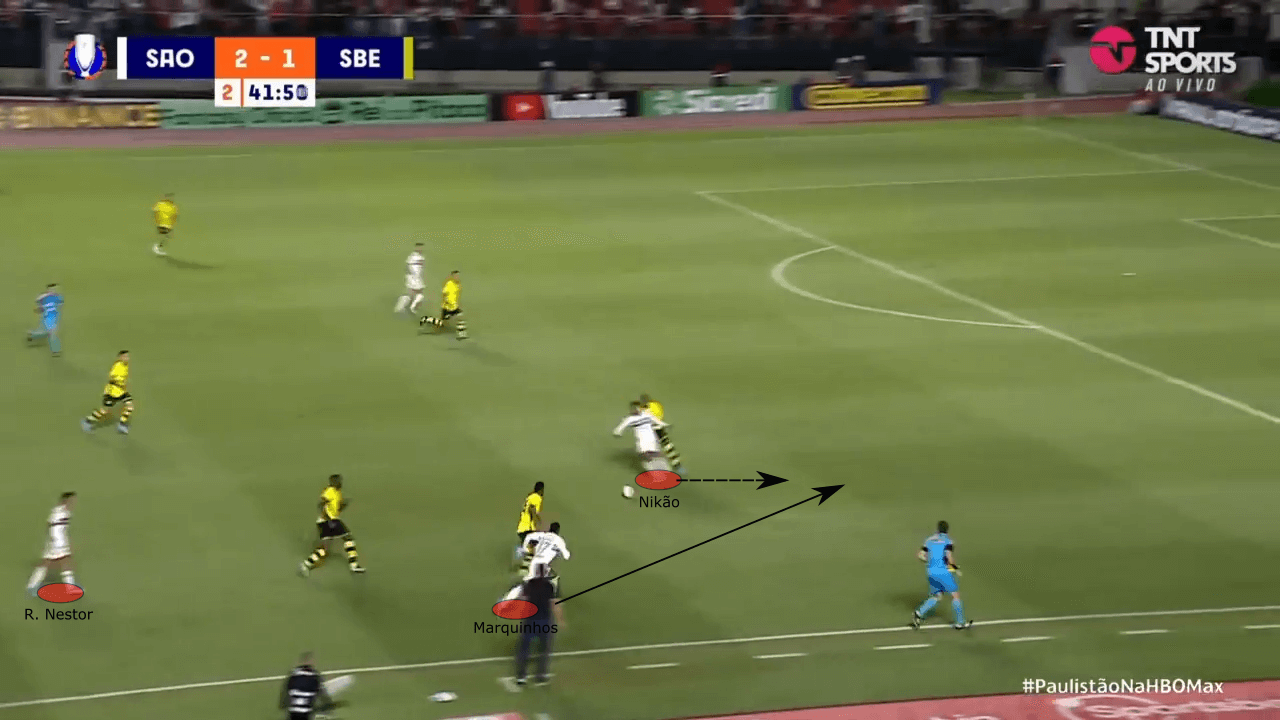
Earlier in the same match, they used the same area of the pitch to create their first goal. As Rigoni drives forward, he passes it wide to Calleri. After passing it, he continues his run and then receives it in behind from Calleri. These pass-and-go combinations are very common in São Paulo’s attack.
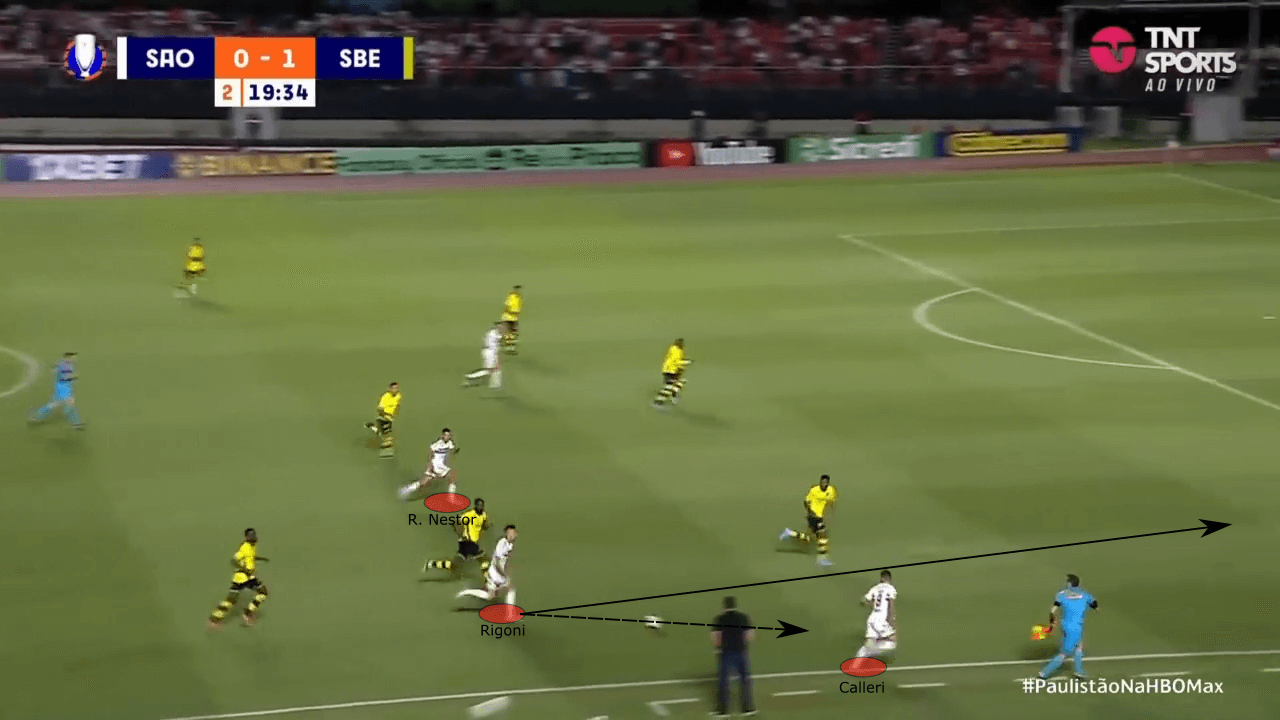
While Rigoni attacks the wide area, Calleri and Nestor drift back inside to provide passing options. Rigoni is able to cut it back for Nestor to score the equaliser.
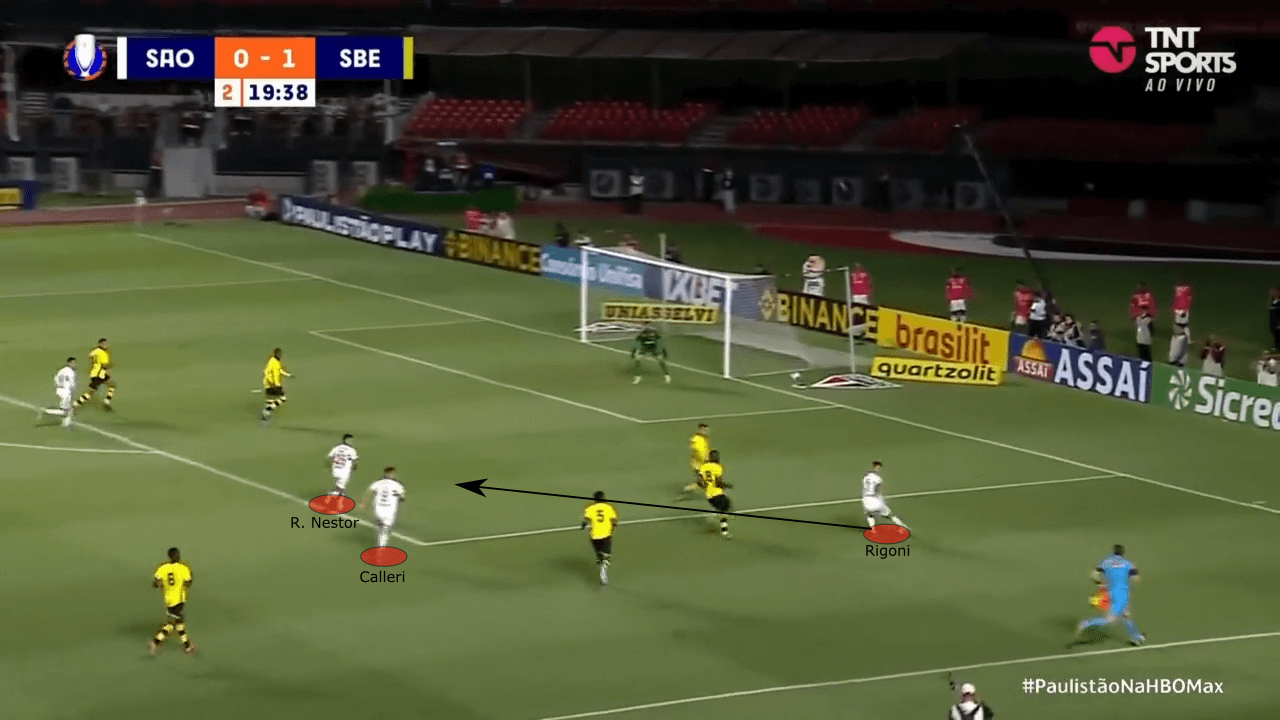
High press
A high press can be done in many different ways. Man-marking or zonal-marking, ball-oriented or space-oriented – the options are endless. Ceni looks to use the overload they have in the midfield to their advantage. After the opposition plays it to a side, São Paulo look to close them in. The attacking midfield trio will move over as a unit with zonal-marking instructions. We will explore this more in detail later. At any rate, the high press is always led by the two centre-forwards. The central attacking midfielder will position himself just behind them.
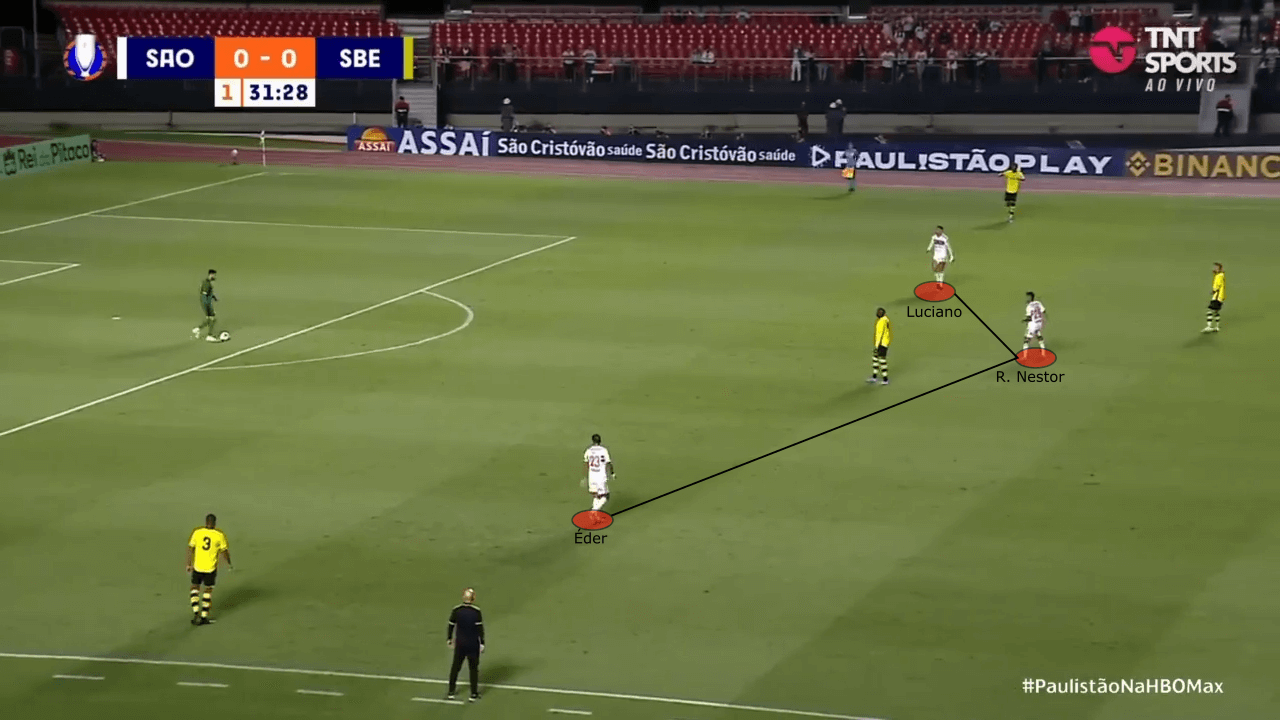
Against Santos, we are able to see their pressing shape in detail. The two centre-forwards lead the first line of pressure with the three attacking midfielders just behind them.
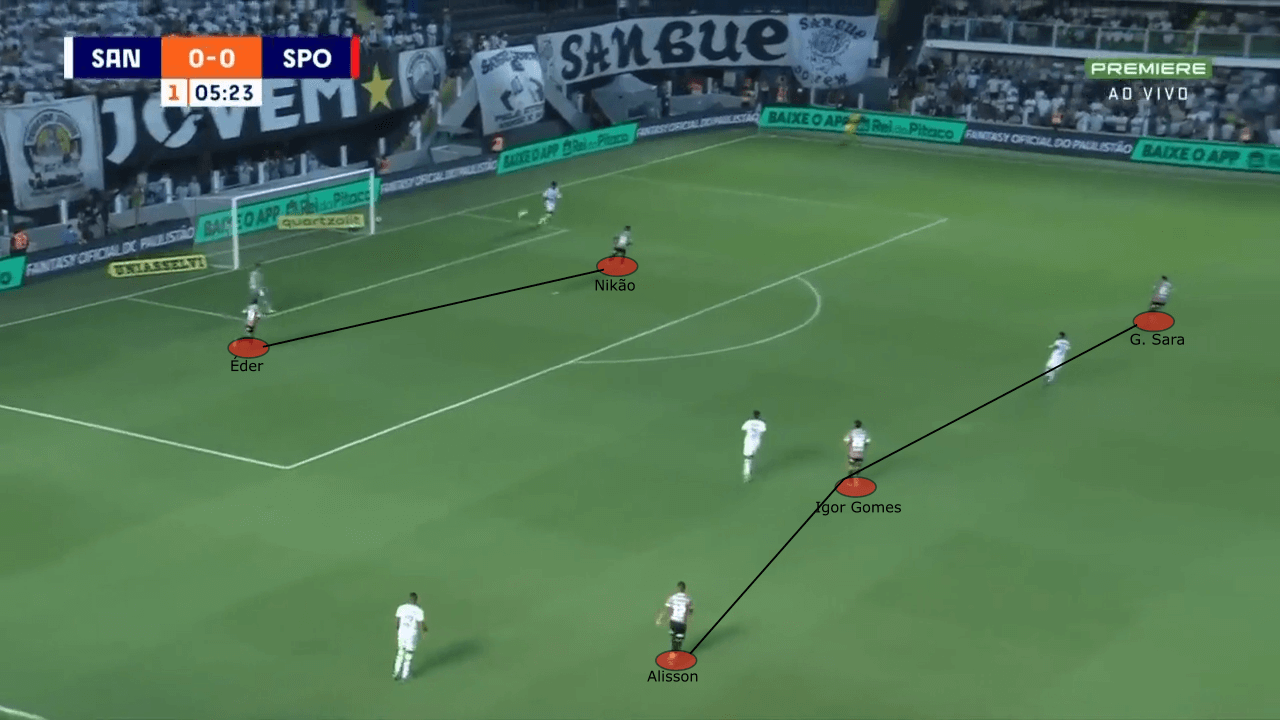
As we have seen, São Paulo have adopted a zonal-marking system. This essentially means players are not marking a certain opposition player the whole time. They will instead mark the nearest opposition player while maintaining their 4-1-3-2 structure. Although it requires a high level of communication and coordination, São Paulo have performed it really well. In the instance below, we are able to see how they maintain their shape while marking the nearest man.
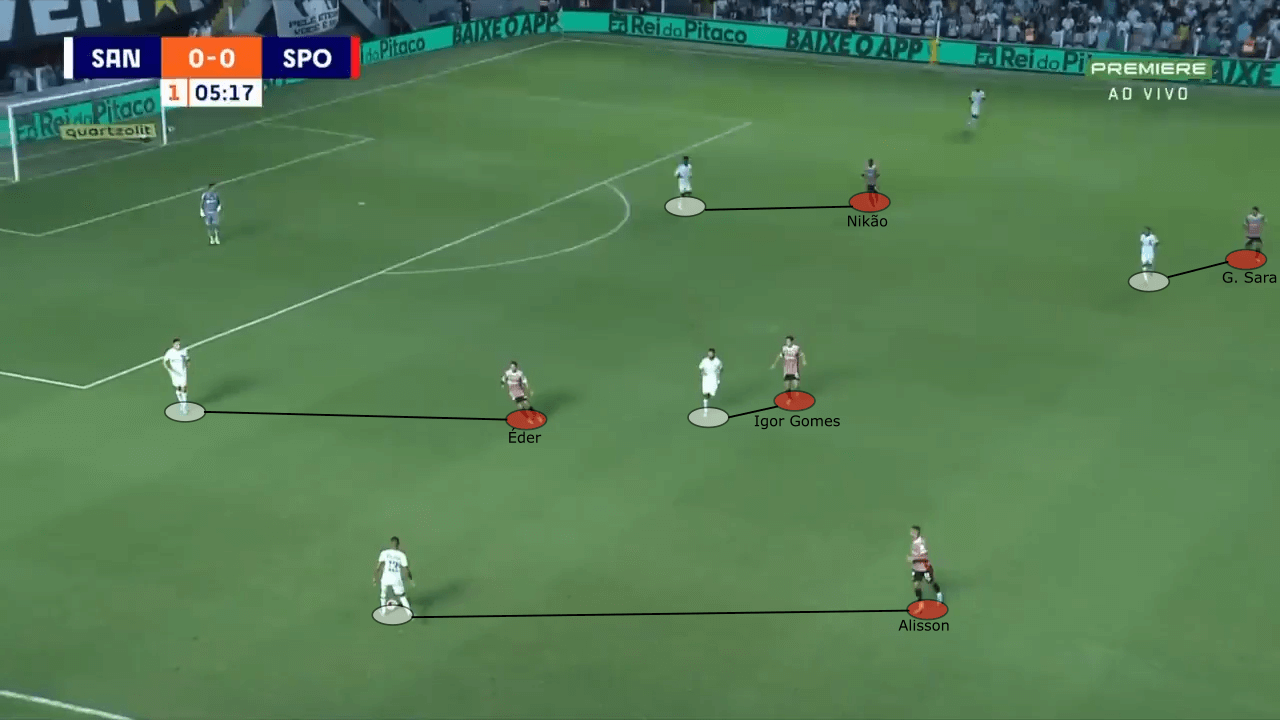
Below is another example of how their zonal-marking. After the opposition plays it to either side, the press advances with the midfield trio moving as a unit. This means the attacking midfielder on the far side does not stay still on the opposite fullback. On the contrary, he will drift inwards and pick up a midfielder. The central attacking midfielder will mark the closest midfielder, or in this case, the second pivot. Finally, the nearest attacking midfielder will usually mark the nearest fullback.
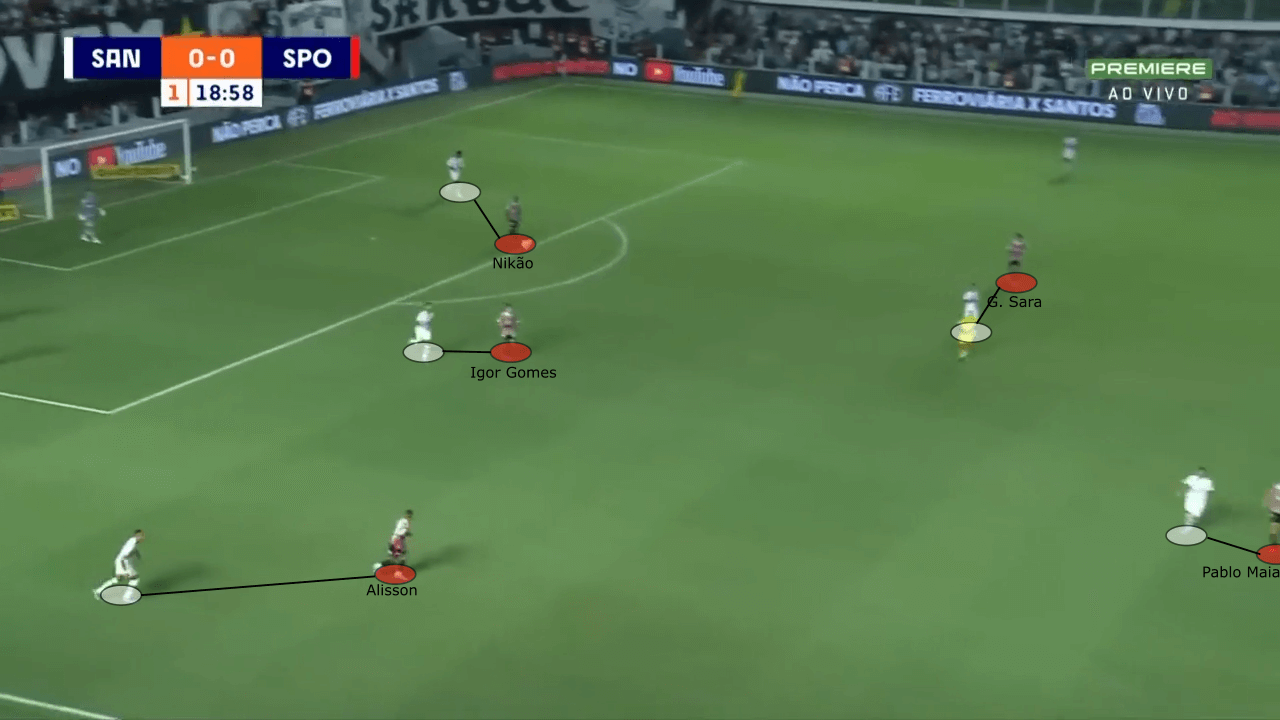
Against Red Bull Bragantino, we are able to see another example of this. As the ball gets switched, Gabriel Sara, the far attacking midfielder, rushes to get back inside and mark the opposite midfielder. The nearest attacking midfielder, in this case, Alisson, advances on the fullback.
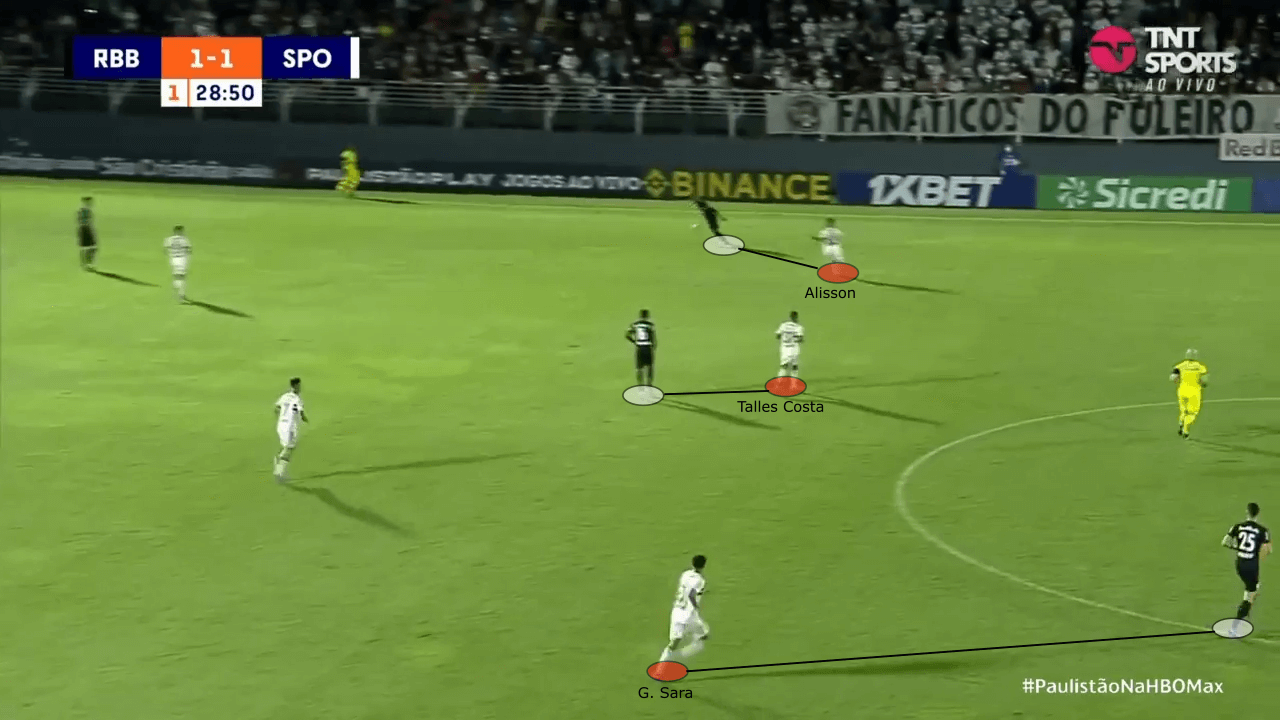
While in a slightly deeper block, we are still able to see their zonal-marking on display. As Danilo moves further into the midfield, Calleri leaves him to press Marcos Rocha, who is about to receive the ball. As Calleri makes this switch in marking, Rodrigo Nestor immediately steps up to mark Danilo.
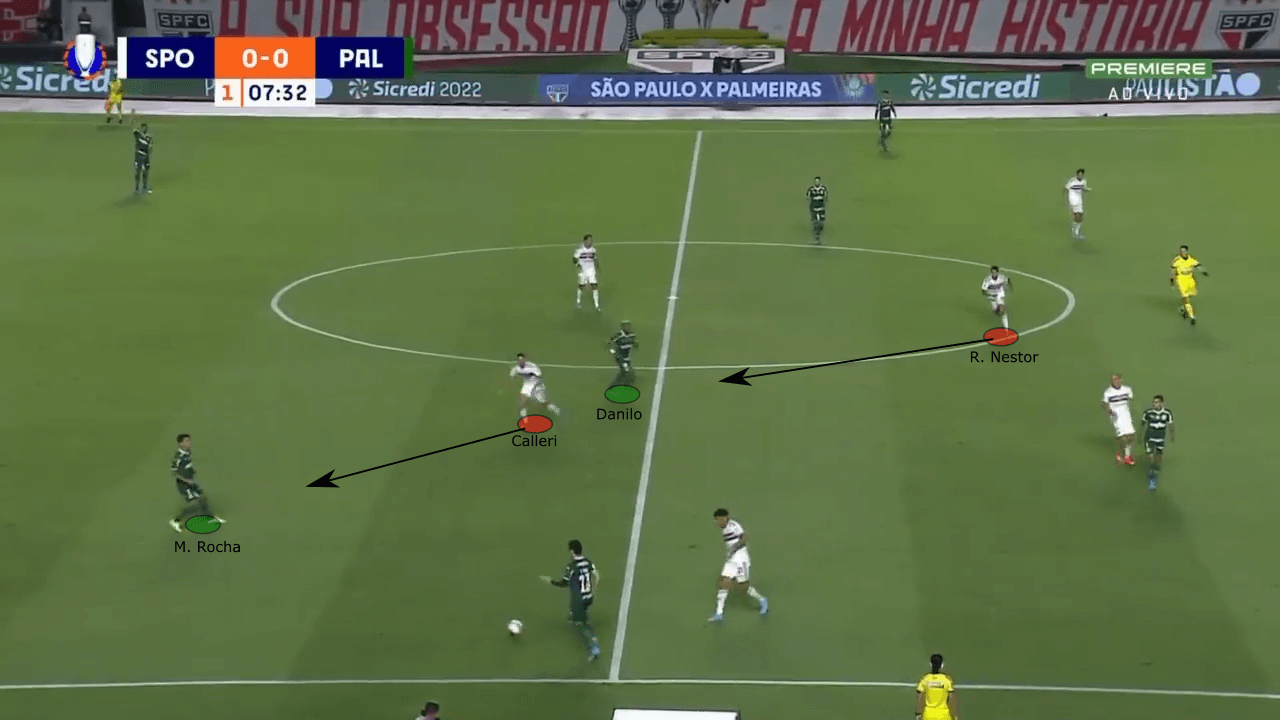
Defensive organisation
In lower blocks, São Paulo revert to a much more compact structure. The central attacking midfielder, usually Nestor, will drop in alongside Pablo Maia. Meanwhile, the two wide attacking midfielders will flank the two, forming two lines of four. The image below illustrates this more compact organisation in lower blocks.
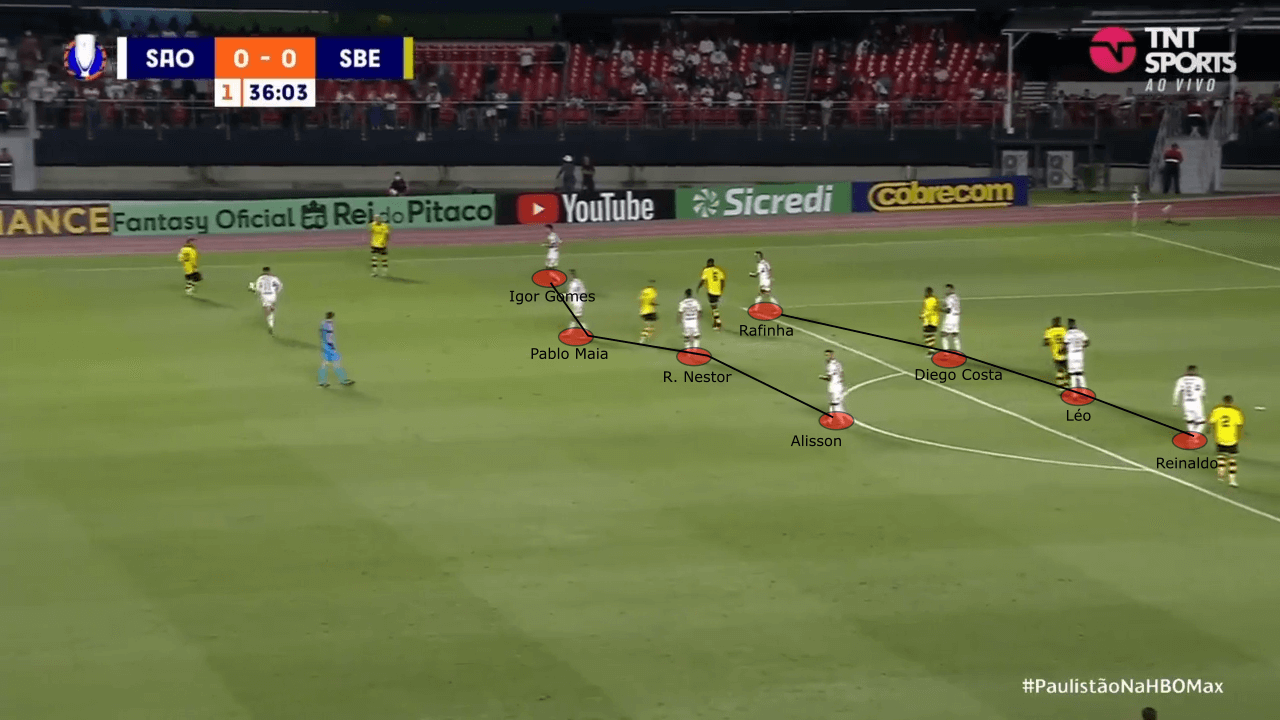
Against Santos, we are able to see an example of the two lines once again. The space between the two lines is very limited in order to minimise the spaces in their own third. This makes it very difficult for the opposition to create and break this defensive block down. It also requires constant communication and coordination, as one player out of position can be fatal.
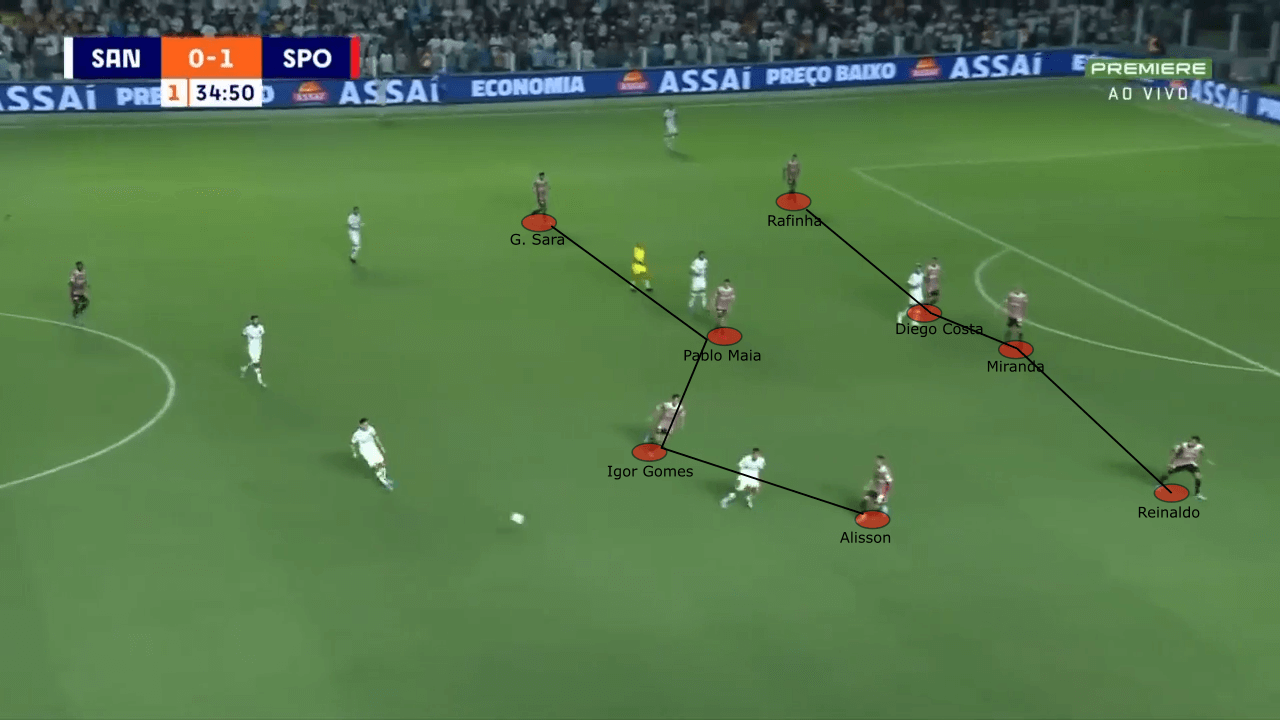
This compactness can be further illustrated in the image below. São Paulo have nine players in that small area where São Bernardo is trying to attack. By making the pitch, and consequently the spaces, smaller for the opposition, they are able to defend more effectively.
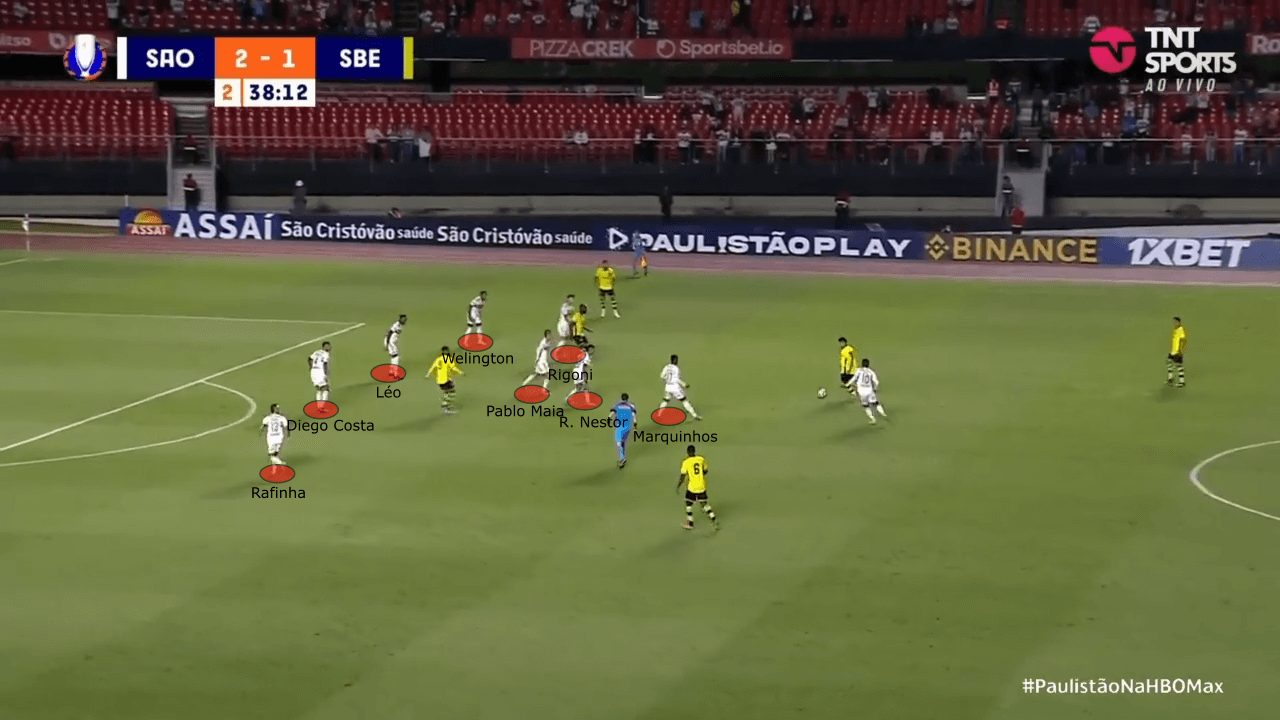
Finally, Igor Gomes’ behaviour against Santos further illustrates São Paulo’s defensive behaviour. They do not want to allow the opposition time or space on the ball, especially in their own half. As the ball moves into the midfield, Igor Gomes steps up from the midfield four to press the ball carrier. This applies pressure and does not allow him time or space to create.
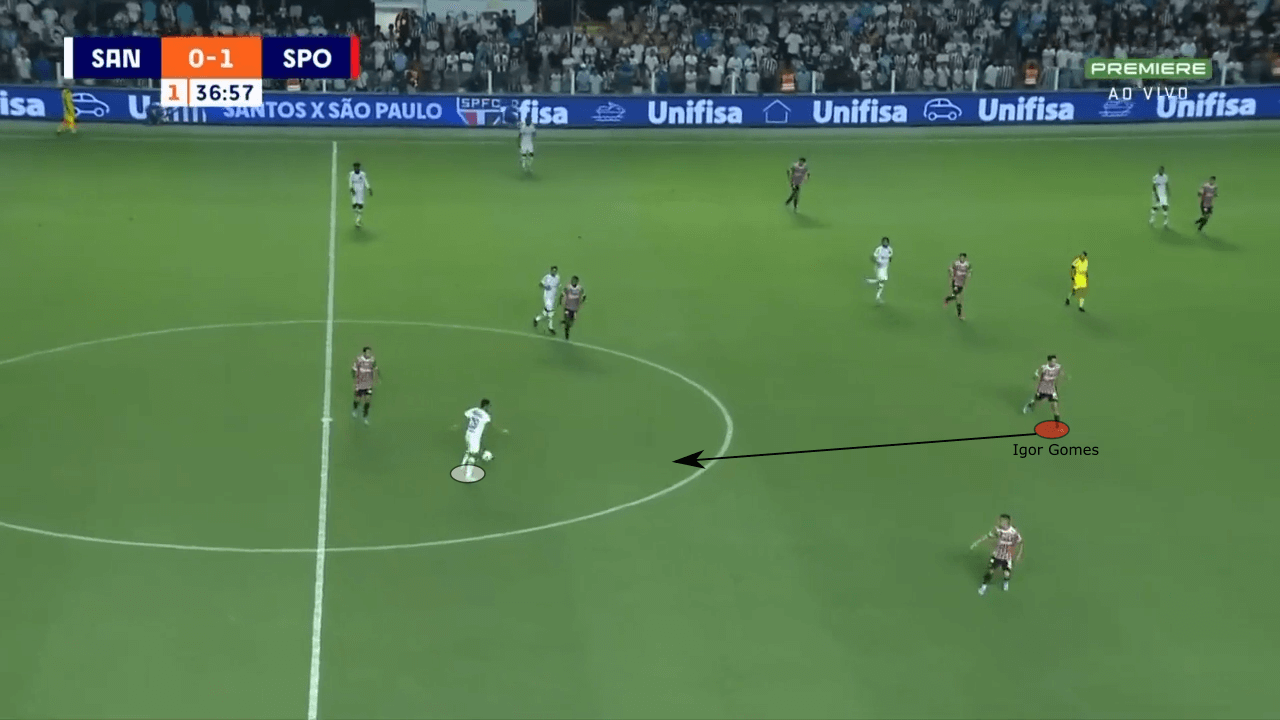
As Igor Gomes steps up closer to the ball carrier, Alisson drops a little to provide cover. By dropping a little, he is able to cover or intercept any balls played between the lines. The same can be said about Pablo Maia as he steps closer to Igor.
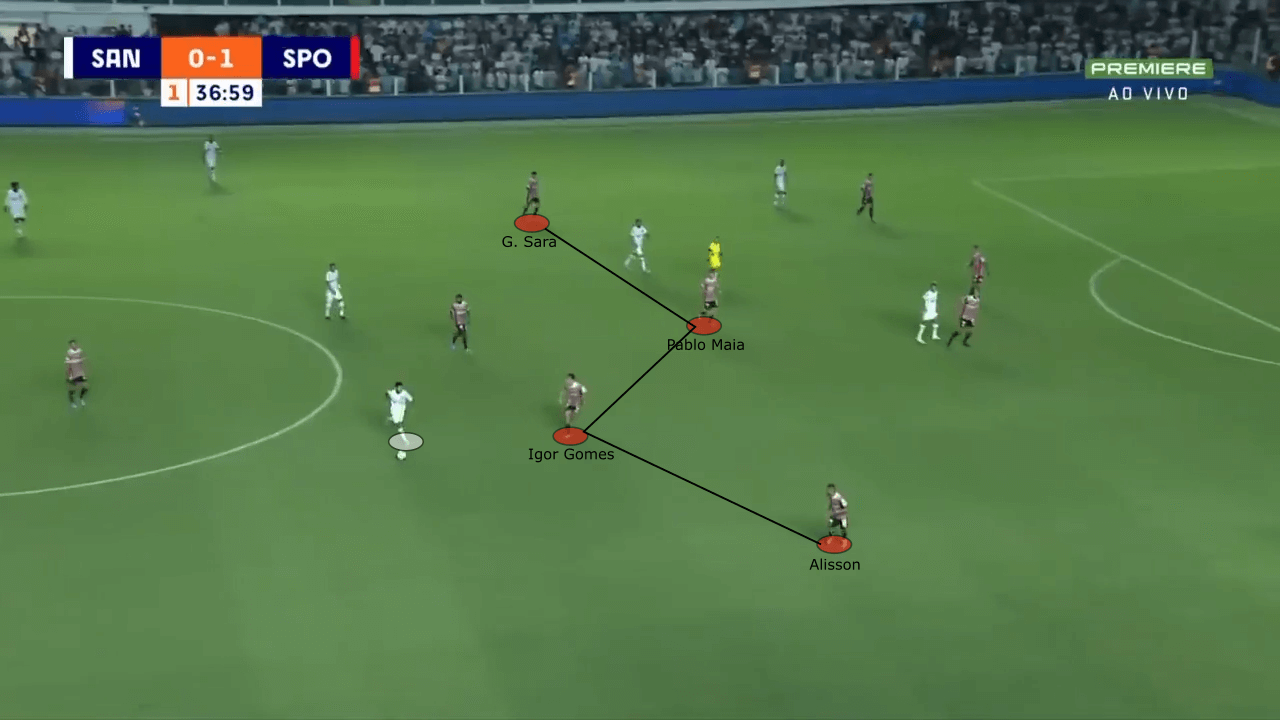
After playing it wide, the ball carrier makes a run into the final third. Igor Gomes stays with him in order to keep him from receiving and being a threat. Subtle coordinated movements and a relentless work rate to not allow the opposition space on the ball have allowed São Paulo to be very effective defensively.
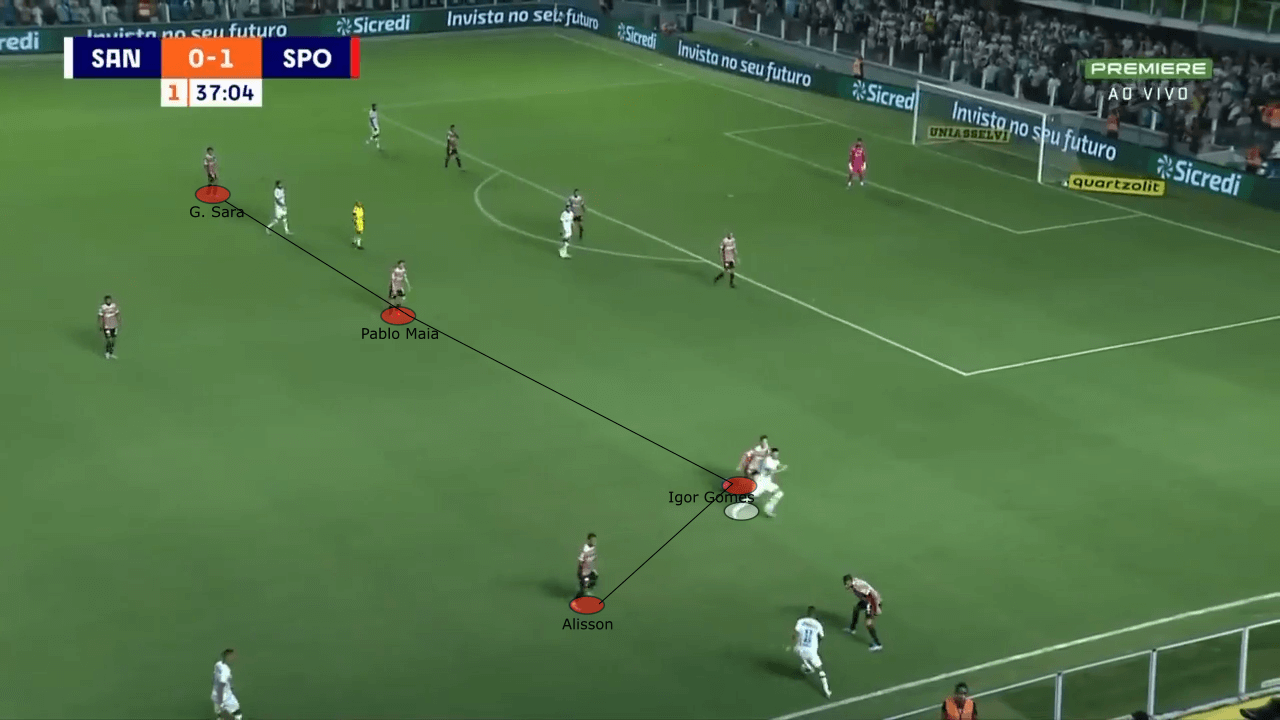
Conclusion
São Paulo have had a great start to their 2022 campaign under Ceni. They have been able to build a well-balanced squad with both youth and experience. Furthermore, their tactics have been very effective and pleasing to watch. They aim to control possession and collectively progress through the zones. Their coordinated movements and organised structure allow them to be effective. On the defensive end, they adopt a high press system based on zonal-marking. In lower blocks, their compact structure makes them a very hard team to break down. In summary, Ceni has implemented a successful playing model in all phases of the game. The potential is definitely high for the 2022 season as Ceni tries to prove himself as one of Brazil’s best managers.





Comments